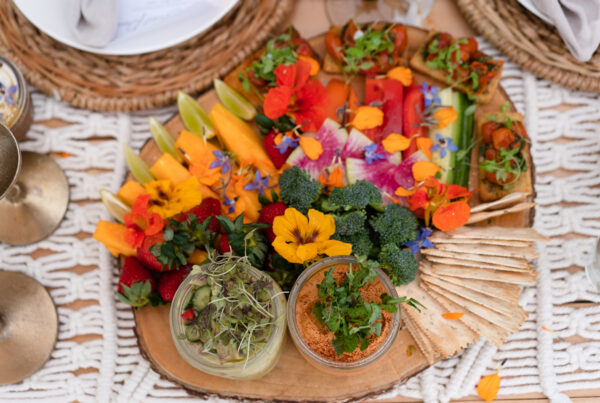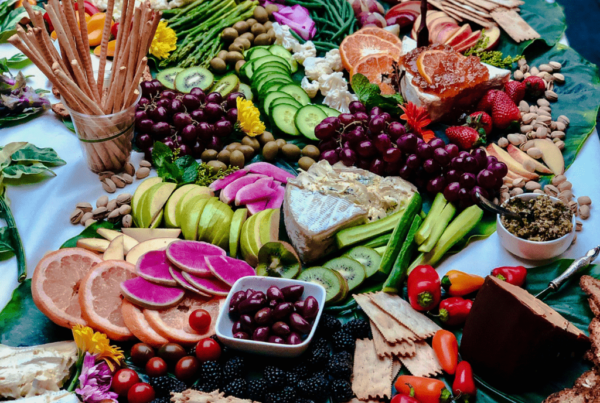Hawaii Superfoods: Ancient Ingredients with Modern Health Benefits
Hawaii’s lush landscapes are home to a rich variety of amazing plants that have nourished various cultures for centuries. These unique ingredients are not only deeply rooted in Hawaiian and Polynesian, culture but are also powerhouses of nutrition.Whether you’re looking to explore new flavors or enhance your plant-based diet with nutrient-dense foods, Hawaiian ingredients offer an exciting culinary journey.
Let’s dive deeper into the cultural roots, and health benefits of favorite local Hawaiian ingredients to incorporate into creative menus —along with some simple recipe ideas to try at home.
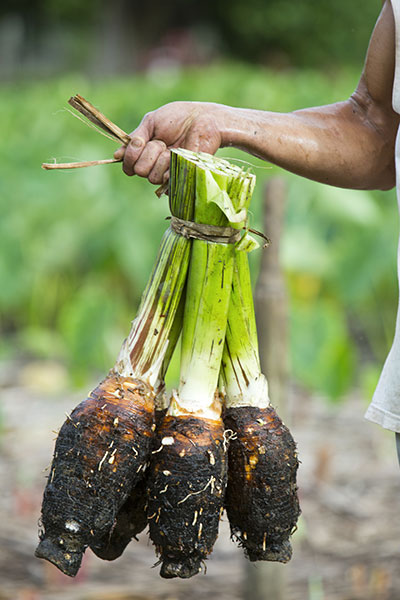
Taro / kalo
History and Hawaiian Name:
Kalo, or taro, holds a central place in Hawaiian culture, often regarded as one of the most sacred plants in the islands. It has been cultivated in Hawaiʻi for more than 1,500 years and is deeply intertwined with Hawaiian mythology. In Hawaiian creation stories, kalo is believed to be the original ancestor of the Hawaiian people.
According to legend, the first kalo plant grew from the buried body of Hāloa, the stillborn son of the god Wākea and the goddess Hoʻohokukalani, giving birth to the Hawaiian people who are thus connected to the land and its bounty. This powerful symbolism underscores kalo’s importance, not just as a crop, but as a spiritual and cultural foundation in Hawaiian life.
In traditional Hawaiian agriculture, kalo is grown in loʻi (irrigated terraces) and harvested to be used in a variety of dishes. One of its most notable uses is as the main ingredient in poi, a staple food made by pounding steamed kalo into a smooth paste. Poi, rich in nutrients and easily digestible, is often served at traditional Hawaiian feasts or as part of daily meals.
Traditional Use in Hawaiian Culture:
In traditional Hawaiian agriculture, kalo is grown in loʻi (irrigated terraces) and harvested to be used in a variety of dishes. One of its most notable uses is as the main ingredient in poi, a staple food made by pounding steamed kalo into a smooth paste. Poi, rich in nutrients and easily digestible, is often served at traditional Hawaiian feasts or as part of daily meals.
In addition to poi, kalo plays an important role in the preparation of lau lau, a traditional Hawaiian dish that involves wrapping meats (often pork or fish) in the large, nutritious kalo leaves, then steaming them to tender perfection. The kalo leaves, which soften during cooking, lend their earthy flavor to the dish, infusing it with the rich essence of the plant. Lau lau is a prime example of how every part of the kalo plant is utilized, from the root to the leaves, demonstrating the deep respect Hawaiians have for this sacred crop.
Health Benefits:
Kalo is not just a culturally significant plant—it’s also a nutritional powerhouse. Kalo root is high in dietary fiber, which promotes digestion and supports gut health. It’s also rich in vitamins A and C, which help boost the immune system, promote healthy skin, and support good vision. Kalo is naturally low in fat, making it a heart-healthy choice that also provides slow-digesting carbohydrates, ideal for sustained energy throughout the day. The leaves, often steamed in dishes like lau lau, are an excellent source of vitamins, minerals, and antioxidants.
Recipe Idea: Taro Root Chips
Thinly slice kalo root, drizzle with olive oil, and sprinkle with sea salt. Bake at 375°F until crispy for a healthy, crunchy snack that’s naturally gluten-free and lower in fat than traditional potato chips. These kalo chips make a perfect side dish or snack, and their earthy flavor pairs beautifully with your favorite dips or spreads. They offer a modern, plant-based twist on traditional Hawaiian ingredients, bringing together the old and the new in a delicious way.
Kalo Leaves for Steaming Ideas:
Get inspired from traditional lau lau and get creative with what you steam inside these leaves! I also love usTaro leaves, traditionally used in Hawaiian lau lau, offer endless culinary possibilities beyond their classic preparation. Their large, sturdy leaves are perfect for wrapping a variety of ingredients for steaming. Try making creative lau lau by filling taro leaves with tofu, mushrooms, or jackfruit for a plant-based twist, or use them to wrap seafood and root vegetables for a unique, earthy flavor. For a fusion approach, line your steamer baskets with taro leaves when making dim sum or bao buns—the leaves will infuse your dishes with a subtle, smoky flavor while keeping them from sticking to the basket. Experiment with these versatile leaves to add a touch of Hawaii’s rich culinary heritage to your cooking.
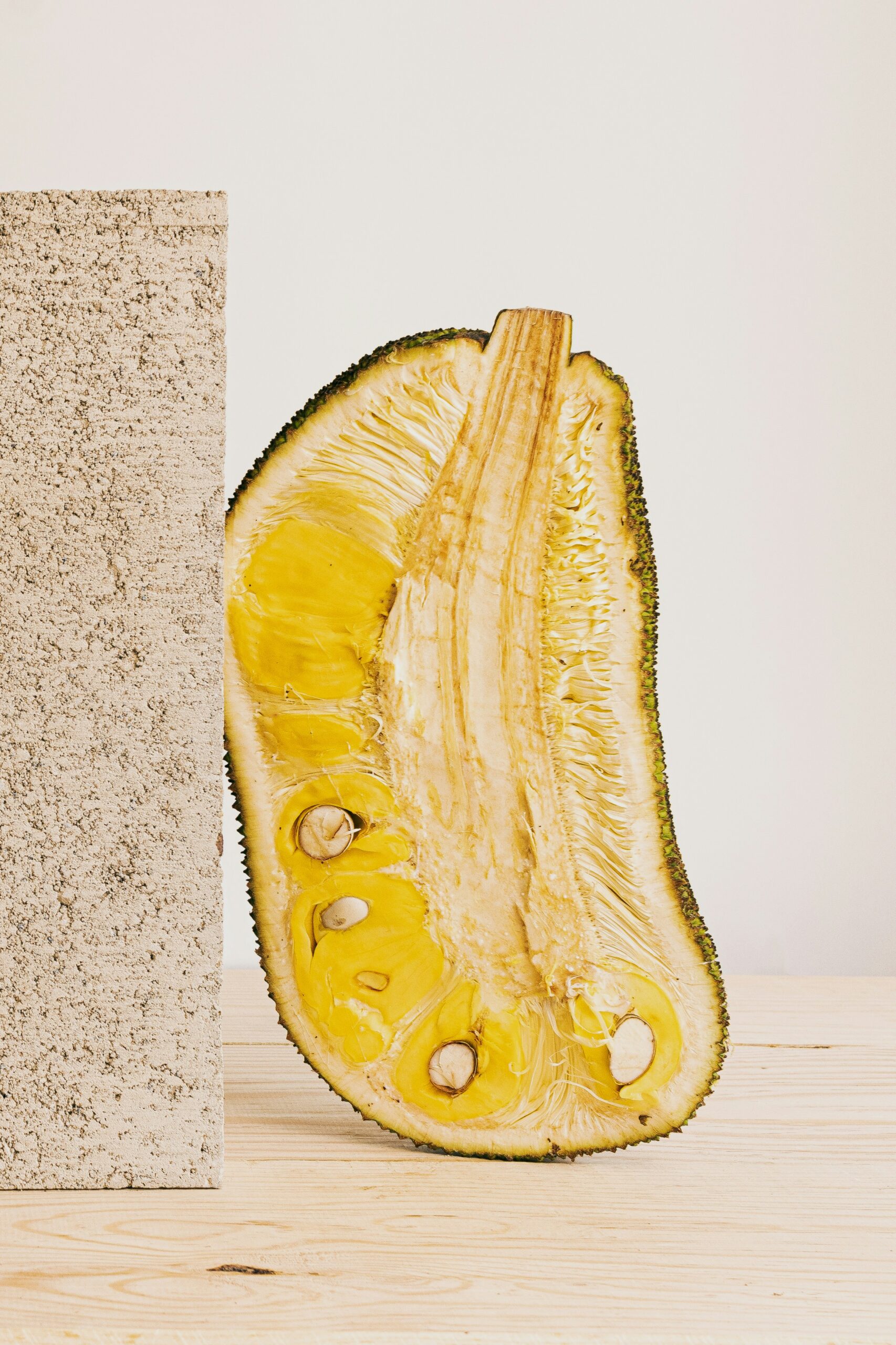
Jackfruit / ʻananaka
History and Hawaiian Name:
While jackfruit isn’t native to Hawaii, it has made its way into the island’s cuisine due to its versatility and texture. Known as ʻananaka, this fruit is a popular meat substitute for vegans and vegetarians in Hawaii, thanks to its ability to mimic pulled pork or chicken when cooked. Its mild flavor and fibrous texture make it an ideal choice for plant-based dishes, allowing it to absorb sauces and spices beautifully.
Traditional Use in Polynesian & Other Cultures:
Although not native to Polynesia, jackfruit has played a significant role in the cuisine of other tropical regions such as Southeast Asia and India for centuries. In India, both the ripe fruit and the seeds are used in a variety of dishes, ranging from curries to desserts. The unripe, green jackfruit is often cooked in savory dishes, acting as a meat substitute due to its ability to take on the flavors of the spices it’s cooked with.
In Southeast Asia, particularly in countries like Thailand and Indonesia, jackfruit is used in both sweet and savory dishes. The ripe fruit is often eaten fresh, added to smoothies, or used in desserts like ice cream and cakes. The seeds are boiled or roasted and enjoyed as a snack. Due to its size and abundance, jackfruit has long been a staple in tropical diets.
In modern Hawaiian and Polynesian cuisine, the adaptability of ʻulu paʻina has made it a rising star in plant-based dishes. Its texture mimics traditional meats used in island fare, such as kalua pork, making it a valuable ingredient for those looking to adopt plant-based lifestyles while staying true to the flavors of the islands.
Health Benefits:
Jackfruit is not just a culinary chameleon—it’s a nutritional powerhouse. Packed with vitamin C, potassium, and dietary fiber, it supports immune health, promotes heart health, and aids digestion, while also being low in calories. Its high antioxidant content helps fight inflammation and supports overall wellness.
Plant-Based Recipe: Mock Pulled Pork Jackfruit Sandwiches
Cook young jackfruit in a sweet and smoky BBQ sauce, then shred it to resemble pulled pork. Serve on a toasted whole-grain bun with tangy coleslaw made from cabbage, carrots, and plant-based mayo. This sandwich delivers the perfect balance of flavor and texture, giving you the indulgence of a BBQ sandwich without the meat. It’s a delicious way to enjoy a plant-based meal with all the savory, comforting flavors of a traditional BBQ.
Random Fun Fact:
The ripe jackfruit is the flavor of Juicy Fruit gum!

Breadfruit / ʻulu
History and Hawaiian Name:
ʻUlu, or breadfruit, is a staple in traditional Hawaiian farming and has been a vital source of sustenance for centuries. Brought to Hawaiʻi by Polynesian voyagers, ʻulu has been cultivated in the islands for over a thousand years. The plant is deeply connected to Polynesian navigation and survival, as it provided a reliable food source on long voyages and helped sustain growing communities in new settlements. The starchy texture of ʻulu makes it an ideal substitute for potatoes or bread in a variety of dishes, earning its place as a versatile and valuable crop in the Pacific Islands.
Traditional Use in Hawaiian and Polynesian Culture:
Breadfruit holds great cultural and agricultural significance throughout Polynesia. In ancient Hawaiʻi, the planting and care of ʻulu trees were part of the agroforestry systems, where trees like breadfruit were intercropped with other essential plants to create sustainable farming systems. ʻUlu was typically cooked in an imu, or underground oven, where it was roasted whole. Once cooked, the soft, starchy flesh was mashed or mixed with coconut milk to create nourishing dishes that were shared communally. In some regions of Polynesia, the fruit is also fermented and preserved for long periods, ensuring that communities have access to food during times of scarcity.
Beyond Hawaiʻi, in places like Samoa and Tahiti, breadfruit continues to be a staple crop. It is often boiled, roasted, or made into a variety of dishes, from savory meals to sweet desserts. The entire tree is considered valuable—its wood is used in carving canoes and its leaves and latex have been used in traditional medicine.
Health Benefits:
Breadfruit is not only a vital crop in Polynesian cultures, but it’s also packed with health benefits. Rich in complex carbohydrates, ʻulu provides a steady, long-lasting source of energy, making it ideal for sustaining physical activities. It’s high in dietary fiber, which promotes digestion and gut health, and contains significant amounts of potassium and magnesium, essential minerals that support heart health and regulate blood pressure. Breadfruit is also low in fat, making it a heart-healthy food choice.
Plant-Based Recipe: Breadfruit Hummus
Roast or steam ʻulu until soft, then blend it with tahini, lemon juice, garlic, and olive oil to create a creamy and filling hummus. This unique spin on a classic dip is perfect for spreading on flatbreads or serving with crunchy raw veggies like cucumbers and carrots. It offers a delightful mix of traditional Polynesian ingredients and modern plant-based cuisine, bringing a wholesome, nutritious dish to your table.
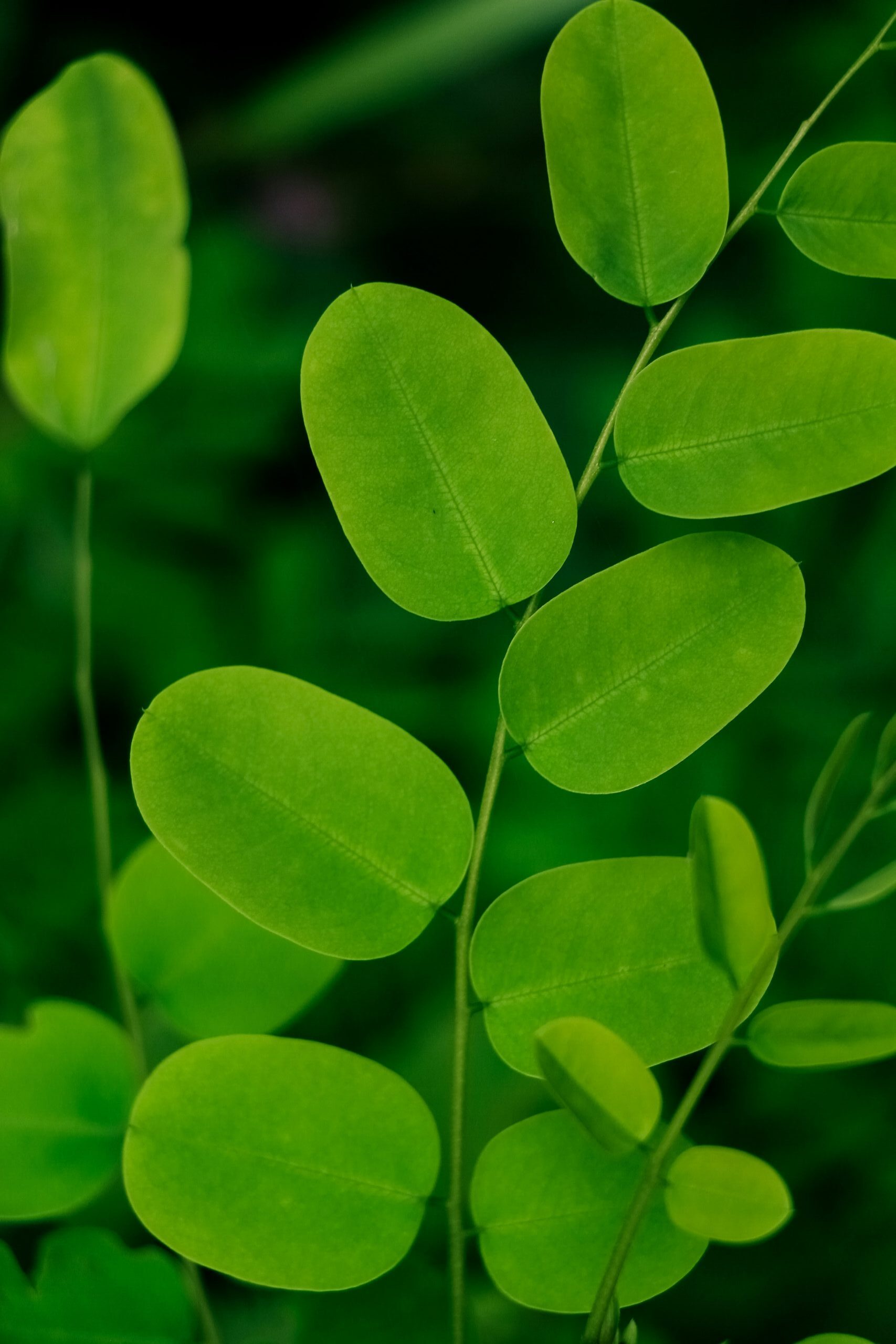
Moringa / kalamungay
History and Hawaiian Name:
Moringa, known as kalamungay in Hawaiʻi, has its roots in India and Southeast Asia but has become a popular plant in Hawaiʻi due to its resilience and incredible nutritional value. While not native to the islands, kalamungay has been embraced in local communities for its ability to thrive in tropical climates. It has been cultivated by immigrant communities, especially those from the Philippines and other Pacific nations, who have long recognized its medicinal and nutritional benefits. Valued as a potent superfood, moringa is often referred to as the “miracle tree” because nearly every part of the plant—leaves, seeds, pods, and roots—can be used for food, medicine, or other practical purposes.
Traditional Use in Hawaiian & Other Cultures:
While kalamungay does not have deep roots in ancient Hawaiian traditions, its use has flourished among more recent immigrant groups, such as Filipinos and Pacific Islanders, who have long utilized it for both culinary and medicinal purposes. In the Philippines, moringa (referred to as malunggay) is often added to soups, stews, and stir-fries for its nutrient density. The leaves are boiled to make tea, which is believed to have healing properties, especially for boosting lactation in nursing mothers and supporting general immune health.
In India, where moringa originates, it has been used for thousands of years in Ayurveda, one of the world’s oldest holistic healing systems. Known as “Shigru” in Sanskrit, moringa is used to balance the body’s doshas (vital energies), improve digestion, and support joint health. In West African and Caribbean cultures, moringa leaves are often cooked into sauces or consumed in powdered form for their health-boosting properties.
Health Benefits:
Moringa is often referred to as a “miracle tree” due to its nutritional profile. It contains more protein than most plants, is rich in iron and vitamin C, and is loaded with antioxidants that help reduce inflammation and promote overall wellness.
Plant-Based Recipe: Moringa Smoothie
For an energizing start to your day, I love blending fresh moringa leaves with frozen banana, pineapple, hemp seeds, and spirulina. If you don’t have access to fresh moringa, powdered is great too! The smoothie is not only vibrant in color but packed with nutrients, offering a quick and delicious way to fuel your body with plant-based goodness.
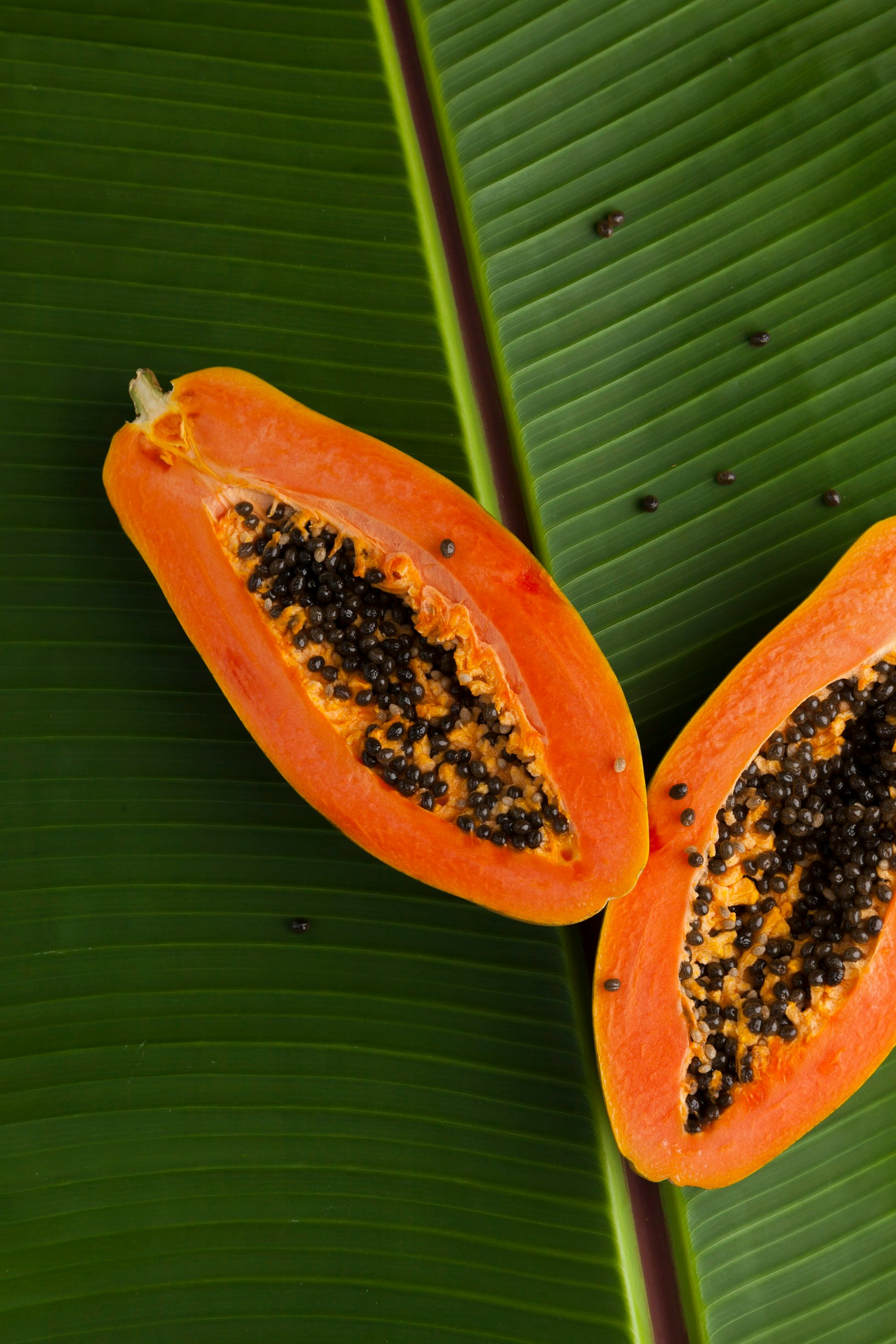
Papaya / mīkana
History and Hawaiian Name:
Papayas, known as mīkana in Hawaiʻi, were introduced to the islands in the early 1800s and quickly became a beloved fruit in Hawaiian cuisine. Originally from Central America, papayas found a perfect home in Hawaiʻi’s tropical climate. While not native to the islands, mīkana has become an important crop, contributing to the local economy and appearing in both traditional and modern Hawaiian dishes. Its sweet, tropical flavor and vibrant color make it a versatile ingredient that bridges both savory and sweet culinary traditions.
Traditional Use in Hawaiian and Other Cultures:
Though papaya doesn’t have deep historical ties to pre-contact Hawaiian culture, its popularity skyrocketed after its introduction to the islands. Hawaiians and other Pacific Islanders have integrated papaya into both everyday meals and festive dishes. The fruit is often served fresh, eaten with lime to enhance its sweetness, or blended into tropical smoothies. Green (unripe) papaya is also used in savory dishes, providing a crisp texture to salads and sides.
In Southeast Asia, particularly in Thai and Laotian cuisine, green papaya is a key ingredient in som tam, a spicy salad known for its vibrant mix of sweet, sour, and spicy flavors. This dish has influenced the use of green papaya in Hawaiʻi’s culinary scene as well. In Caribbean and Central American cultures, ripe papaya is often eaten as a breakfast fruit or added to salsas and salads, while the seeds are sometimes dried and used as a peppery spice.
Health Benefits:
Papaya is celebrated not only for its delicious taste but also for its numerous health benefits. It is rich in papain, a digestive enzyme that aids in breaking down proteins and promotes gut health. Papaya also contains high levels of vitamins A and C, which are essential for boosting the immune system and maintaining healthy skin. Its antioxidants help fight inflammation and oxidative stress, making it a great choice for supporting overall wellness. Additionally, the fiber content in papaya contributes to heart health by lowering cholesterol levels and improving digestion.
Plant-Based Recipe: Green Papaya Salad
Shred green, unripe papaya and mix it with fresh herbs, lime juice, soy sauce, and chili for a refreshing salad that offers a balance of sweet, sour, and spicy flavors. This dish, inspired by Southeast Asian cuisine, is perfect as a light appetizer or a flavorful side to a heartier meal. The crunch of the papaya combined with the bright acidity of lime and the heat of chili makes this salad a vibrant, healthy addition to any table.
Other Recipe Ideas:
I’ve been stuck catering in the jungle and needed extra veggies, and I learned that green papaya can be treated like a squash-potato hybrid! Stir fry it, put in a coconut curry, steam it. Easy and literally grows on trees!
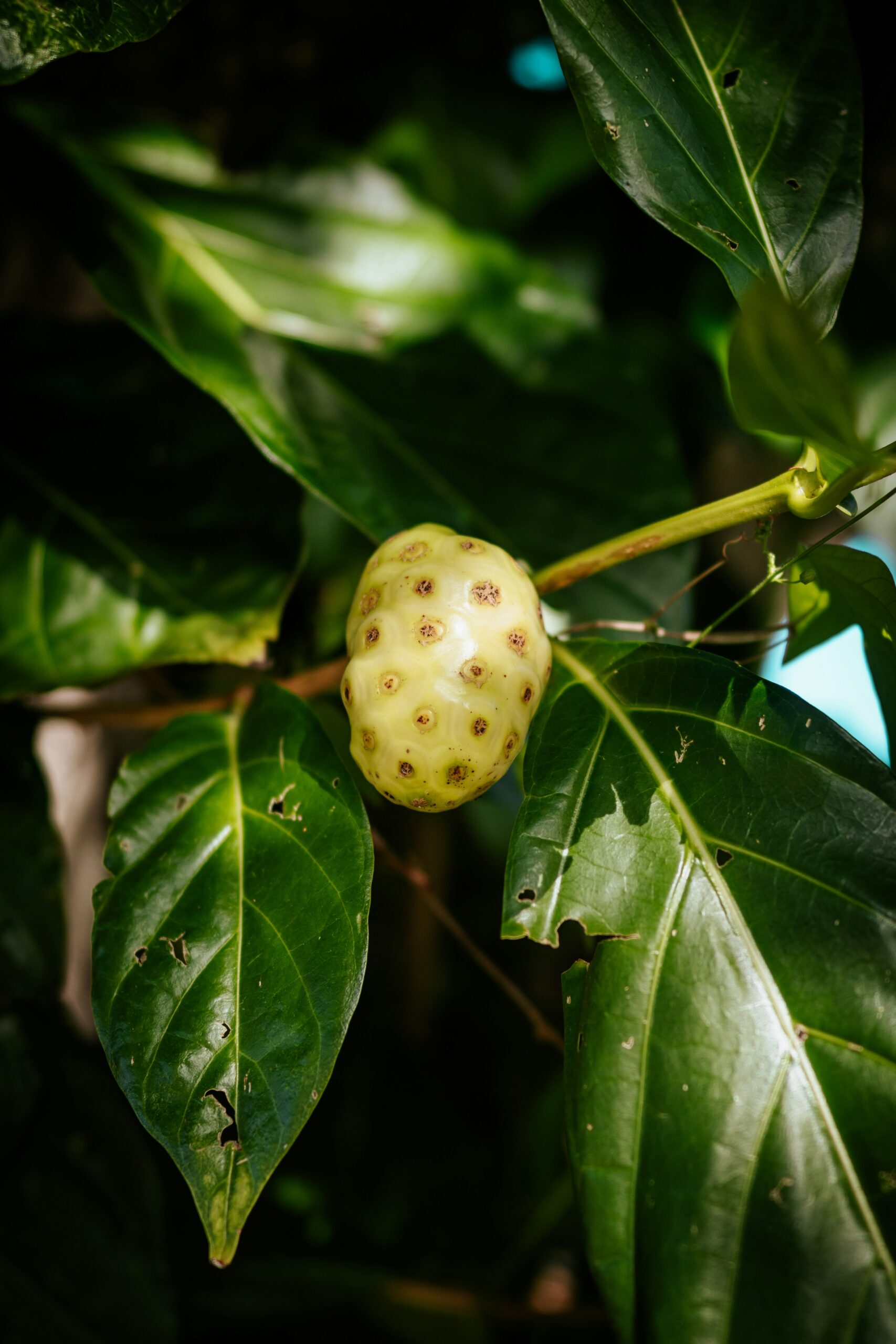
Noni / nō’-ni
History and Hawaiian Name:
Noni, also known as Indian mulberry or Morinda citrifolia, has been a revered plant in Polynesian culture for centuries. Known as noni in Hawaiʻi, it was brought to the islands by the early Polynesian voyagers, who recognized its medicinal properties. Noni grows easily in the wild and has long been used in traditional Hawaiian medicine (lāʻau lapaʻau) for its healing powers. Although its strong, pungent aroma and flavor can be off-putting, noni has earned a reputation as a powerful superfood and natural remedy.
Traditional Use in Hawaiian and Polynesian Cultures:
Noni has been used extensively in Polynesian and Hawaiian healing practices for thousands of years. Every part of the noni plant—fruit, leaves, roots, and bark—has medicinal applications. Traditionally, the fruit was mashed into a pulp or juice and used to treat various ailments, from infections and inflammation to digestive issues and skin conditions. Noni leaves were often applied topically to reduce swelling, while the bark and roots were used in herbal remedies for internal health.
Although the taste of noni fruit can be quite bitter and sour, its health benefits far outweighed its unappealing flavor in ancient times. Today, noni is often consumed in juice form, sometimes mixed with other fruits to balance its flavor, but its medicinal legacy continues throughout the Pacific.
Health Benefits:
Noni is loaded with antioxidants, particularly vitamin C, which helps protect the body from oxidative stress and boosts the immune system. It is also rich in potassium, which supports heart health by regulating blood pressure. Noni’s anti-inflammatory properties make it a valuable natural remedy for reducing inflammation in the body, particularly for joint and skin health. Additionally, noni is believed to improve digestion and support gut health due to its antibacterial and antifungal properties. In Hawaiian lāʻau lapaʻau, noni has long been used as a tonic for overall wellness and longevity.
Plant-Based Recipe Idea: Noni Smoothie Elixir
Blend fresh or powdered noni with coconut water, pineapple, banana, and ginger to create a nutrient-dense smoothie that masks the strong flavor of the noni. The sweetness of the pineapple and banana pairs well with the natural bitterness of noni, while the ginger adds a spicy kick that also supports digestion. This elixir provides a powerful boost of antioxidants, vitamins, and hydration—perfect for jump-starting your day or as a refreshing midday pick-me-up.
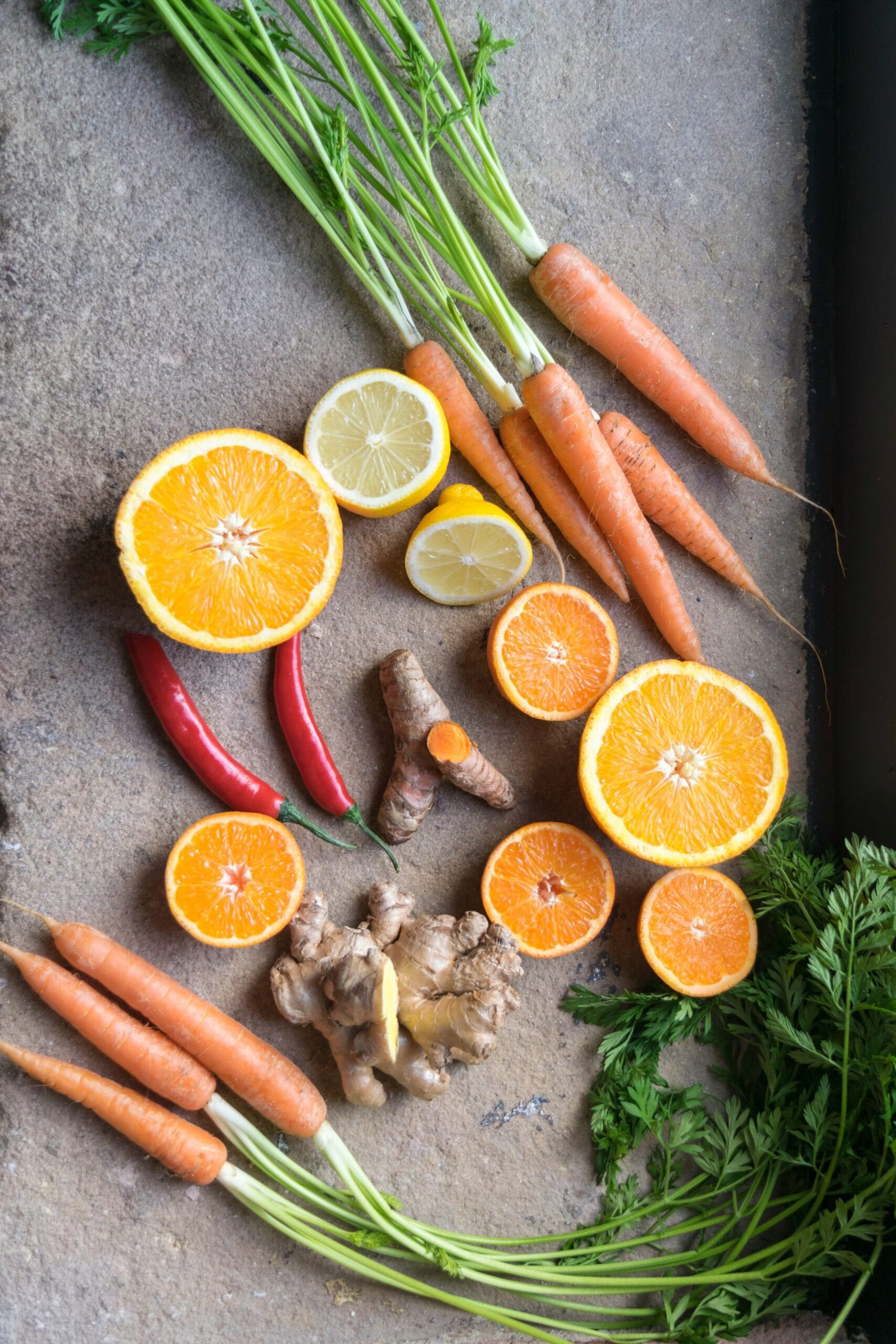
Turmeric / ʻōlena
History and Hawaiian Name:
ʻŌlena, or turmeric, has been used in Hawaiʻi for centuries, having been brought to the islands by the early Polynesian voyagers. Known for its vibrant orange color and earthy flavor, ʻōlena is highly valued not just for its culinary uses but also for its medicinal and spiritual significance. Traditionally, Hawaiians used ʻōlena in healing practices and as a dye for kapa (bark cloth). Its sacred properties made it an essential plant in rituals and ceremonies aimed at purification and protection.
Traditional Use in Hawaiian and Polynesian Cultures:
ʻŌlena has been used for generations in Hawaiian lāʻau lapaʻau (traditional medicine) for its powerful anti-inflammatory and healing properties. It was often mashed into a paste and applied topically to treat wounds or ingested to support the immune system and digestive health. In addition to its medicinal uses, ʻōlena was used in purification rituals, where its juice was sprinkled around homes or altars to protect against negative energy.
In Polynesian culture, as well as in India and Southeast Asia, turmeric has been a staple spice for centuries, known for its health benefits and rich flavor. It is a key ingredient in Indian Ayurvedic medicine, often used to balance the body’s doshas and promote longevity. Today, ʻōlena is widely embraced in Hawaiʻi’s culinary scene for its flavor and wellness benefits.
Health Benefits:
Turmeric (ʻōlena) is widely known for its potent anti-inflammatory properties, primarily due to its active compound curcumin. Regular consumption of turmeric can help reduce inflammation, which is linked to a variety of chronic conditions, including heart disease and arthritis. Additionally, turmeric is a powerful antioxidant, helping to neutralize free radicals and support overall wellness. It is also known to boost the immune system, improve digestion, and promote healthy skin. When combined with black pepper (piperine), the absorption of curcumin is enhanced, making its health benefits more potent.
Plant-Based Recipe Idea:Golden Turmeric Latte
Create a warming, immune-boosting turmeric latte by mixing ground turmeric (or fresh grated ʻōlena), black pepper, cinnamon, and ginger into your choice of plant-based milk (such as almond or coconut milk). Sweeten it with a touch of maple syrup or honey, and simmer gently to allow the flavors to infuse. This golden latte is rich in antioxidants and anti-inflammatory compounds, making it the perfect drink to support overall wellness, reduce inflammation, and provide a cozy, comforting beverage any time of day.
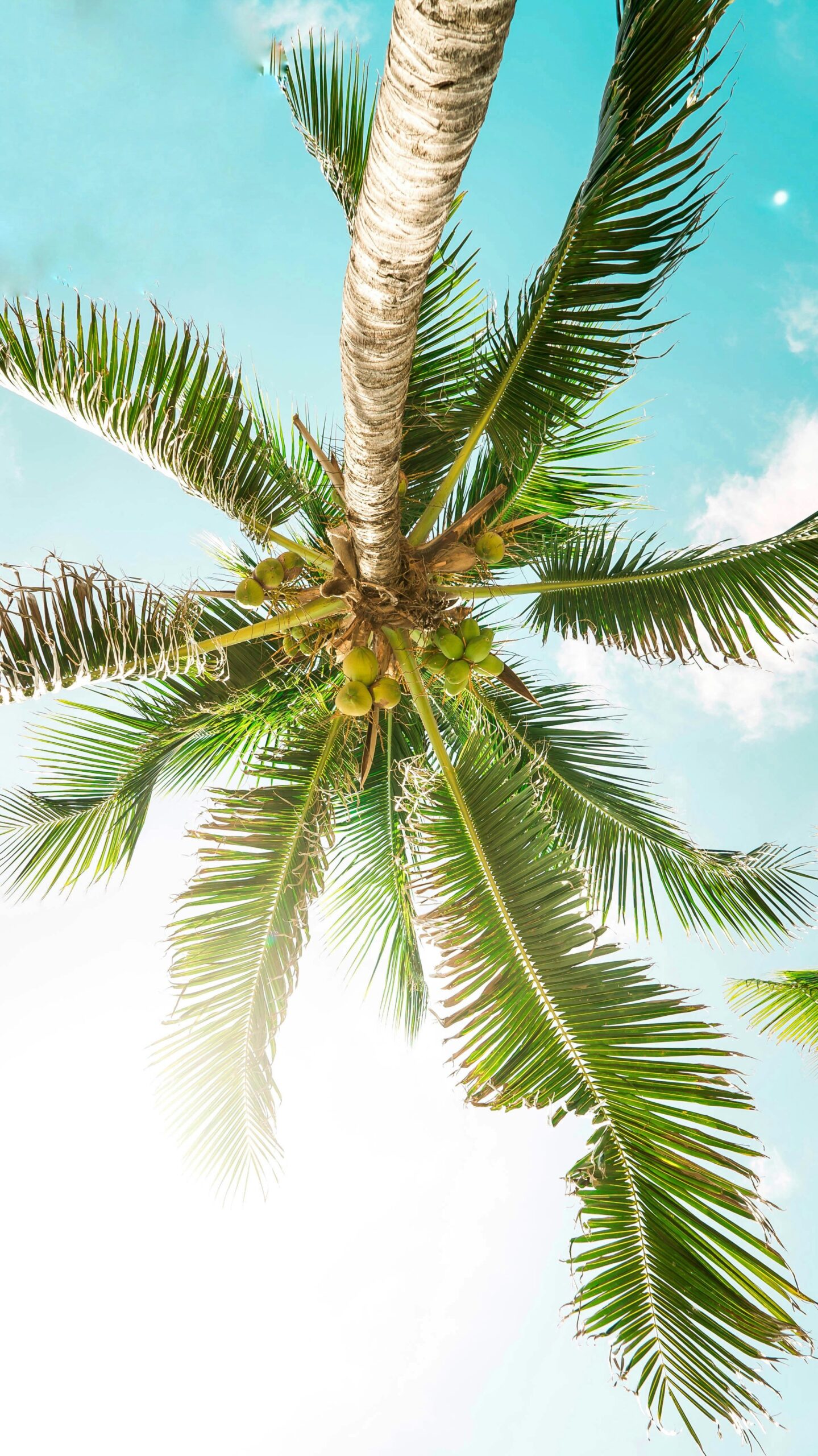
Coconut / niu
History and Hawaiian Name:
Niu, or coconut, is one of the most important plants in Polynesian culture, and its introduction to Hawaiʻi by early voyagers transformed the islands’ agriculture. Niu is revered for its many uses—from the nutritious coconut meat and water to its fibrous husk, which is used for making ropes and mats, and its leaves, which can be woven into baskets and thatching. The coconut tree is sometimes referred to as the “tree of life” because of its incredible versatility and importance to daily life across Polynesia and other tropical regions.
Traditional Use in Hawaiian and Polynesian Cultures:
In traditional Hawaiian and Polynesian culture, niu was used for much more than just food. The coconut fruit provided sustenance in the form of coconut water and meat, while the oil extracted from the meat was used in cooking, medicine, and skin care. Coconut water was consumed as a hydrating beverage, and the meat was eaten fresh or dried for long-term storage. The sap from young blossoms could be tapped for a sweet drink, while the husk and shells were used to make tools, bowls, and ropes. Niu was also a key ingredient in ceremonial offerings and traditional medicine (lāʻau lapaʻau), where it was applied topically to treat skin conditions and consumed to improve digestion and overall vitality.
In other tropical regions, such as Southeast Asia, the coconut is equally revered. Coconut milk and oil are foundational ingredients in many traditional dishes, from curries to desserts. The use of coconut in both savory and sweet dishes has transcended cultures and borders, making it a global culinary staple.
Health Benefits:
Coconut is highly nutritious and rich in fiber, vitamins, and minerals. Coconut meat provides healthy fats, primarily medium-chain triglycerides (MCTs), which are quickly metabolized and can be a source of energy for the body. Coconut water is a natural electrolyte-rich drink, making it ideal for hydration and replenishing lost minerals. Additionally, coconut oil is known for its anti-inflammatory and antimicrobial properties, benefiting skin health and supporting the immune system. Consuming coconut regularly can aid digestion, improve heart health by boosting good cholesterol (HDL), and provide a natural energy boost.
Plant-Based Recipe Idea: Coconut Curry Soup
Create a creamy, nourishing coconut curry soup by simmering coconut milk with vegetable broth, garlic, ginger, and your favorite curry paste. Add seasonal vegetables like sweet potatoes, carrots, and spinach for added texture and nutrients. Serve this flavorful soup with fresh herbs and a squeeze of lime for a plant-based meal that’s rich in healthy fats, fiber, and antioxidants. This dish is comforting yet light, providing a perfect balance of warmth and nutrition.
Bringing Hawaiian Superfoods to Your Kitchen
As a chef, integrating Hawaii superfoods into plant-based meals not only enhances their nutritional value but also pays homage to the ancient wisdom of Hawaiian and Polynesian cultures. By using ingredients like the sacred kalo, nutrient-rich ʻōlena (turmeric), and versatile niu (coconut), you create dishes that are not only delicious but deeply connected to the islands’ agricultural and cultural heritage. These Hawaiian superfoods offer a bounty of flavors and health benefits, from the vibrant jackfruit’s meat-like texture to the powerful healing properties of moringa.
By embracing these traditional Hawaiian ingredients, you bring the spirit of the islands to your table. Whether it’s crafting modern spins on classic dishes or experimenting with unique combinations, these ingredients open up endless culinary possibilities. Tap into the ancient wisdom of Hawaiian agriculture and Polynesian food traditions to inspire new plant-based creations that are vibrant, flavorful, and deeply nourishing. Exploring and incorporating these Hawaii superfoods into your cooking allows you to celebrate the islands’ natural abundance and timeless connection between food, health, and culture.



